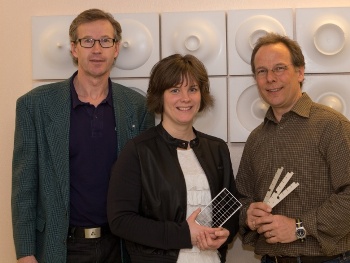Feb 21 2013
The European Spallation Source (ESS) in Lund has been granted its first patent in collaboration with researchers at Linköping University. The innovation solves a significant technological challenge faced by many research facilities world-wide, and secures high-class experimental opportunities at the future ESS. It can also be developed for commercial production.
 Lars Hultman, Carina Höglund and Jens Birch, with the detector components covered by a thin film of boron-10-carbide. The components will be used for a prototype for an ESS detector. Photo: Muhammad Junaid
Lars Hultman, Carina Höglund and Jens Birch, with the detector components covered by a thin film of boron-10-carbide. The components will be used for a prototype for an ESS detector. Photo: Muhammad Junaid
The European Spallation Source overcame a significant technological challenge it was facing for its construction and operational phase by inventing a new technology that will be the basis for neutron detectors used in many of its 22 instruments. With the new boron-10-based detectors, ESS will secure efficient and high-class neutron detection in its instruments, and thus the best experimental opportunities for the science community.
Currently, helium-3 is used by scientists for materials research, as a crucial component in neutron instrument detectors. The detectors measure how the neutrons react to a sample studied by a scientist. Therefore, the result of an experiment is dependent on efficient detectors. The growing scarcity of helium-3 has affected all current materials research conducted at neutron science facilities worldwide, and has necessitated the development of new technologies for neutron detection.
In order to guarantee efficient neutron detectors at the future ESS facility, and avoid dependence on helium-3, whose production is extremely limited, and consequently very expensive, the Neutron Detector Group at ESS and scientists at the Thin Film Physics Division at Linköping University launched an extensive R&D work aimed at enabling the use of enriched thin films of boron-10 carbide for ESS’ detector systems, instead of using helium-3.
The patent was recently granted by the Swedish Patent and Registration Office, and is the first registered by ESS. The technology will be further developed through prototyping. ESS also has the ambition to set-up a spin-off company with the goal of exploiting additional market demands, including those of neutron scattering facilities, the logistics sector, and other sectors.
“We are very proud about this first patent for the European Spallation Source, which would not have been possible without the thin-films expertise at Linköping University”, says Colin Carlile, CEO of ESS.
“It allows us not only to secure the detector supplies needed for ESS, but to spin out the production in the framework of our new innovation activities, satisfy further market demands, and contribute to growth and jobs.”
Professor Jens Birch of Linköping University emphasizes how quickly and efficiently the problem could be solved: “So far our group is the only one worldwide that can produce these coatings in a reliable manner”, he says.
“Detector development is crucial for the future scientific programme of ESS. With our new detector technology, we have solved a large technological challenge, and will also secure ESS’s independence of current scarce helium-3 supplies”, says ESS detector scientist Carina Höglund.
The detector R&D has been performed as a collaboration between Dr. Carina Höglund from ESS, Prof. Jens Birch and Prof. Lars Hultman from the Thin Film Physics Division at Linköping University. Their patent covers the invention of “a method for producing a neutron detector component comprising a Boron Carbide layer for use in neutron detecting device”.